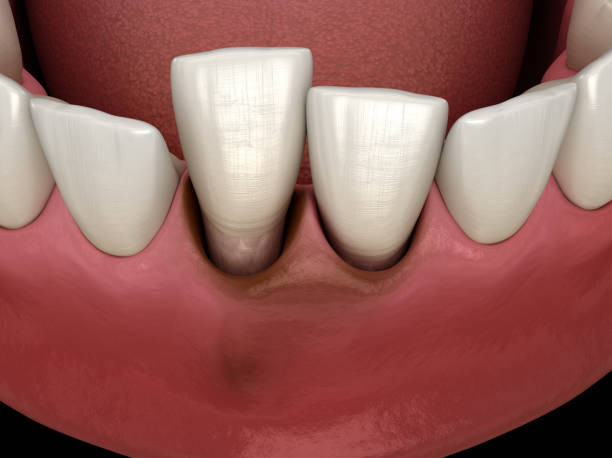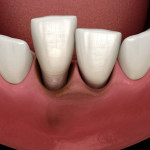Several different treatments can be used for a chipped tooth, depending on the severity of the damage. For minor chips, bonding or tooth contouring may be all that is necessary. More significant chunks may require veneers, crowns, or even dental implants. In cases where the tooth has been completely shattered, it may need to be extracted and replaced with an artificial tooth. Your dentist can determine the best course of treatment for your particular situation.
Your dentist might use a filling to fix the damage if only a tiny bit of tooth enamel has chipped off. In addition, your dentist will probably utilize a technique called bonding, which uses tooth-colored composite resin if the repair is to a front tooth or can be seen when you smile.
Causes of chipped teeth
There are several different causes for teeth to chip. Typical causes include
- Biting into something hard, like ice or hard sweets
- Falls or auto mishaps
- Avoiding a mouth guard when participating in contact sports
- Teeth-grinding when you sleep
Risk factors for chipped teeth
Weak teeth are more likely to chip than solid teeth, which makes it logical. Some factors that weaken a tooth's structure include:
- Cavities and tooth decay destroy enamel. Large fillings can weaken teeth as well.
- Enamel can be worn down by teeth grinding.
- When taken in high quantities, acid-producing foods like fruit juices, coffee, and spicy foods can erode tooth enamel and expose the tooth's surface.
- Acid reflux and heartburn, two digestive disorders, can cause stomach acid to rise into your mouth and harm your teeth's enamel.
- Eating problems and heavy drinking can lead to frequent vomiting, releasing acid that eats away at the enamel.
- In your mouth, sugar causes the growth of microorganisms that can damage enamel.
- Because tooth enamel deteriorates over time, if you're 50 years or older, you run a higher risk of developing weak enamel. Nearly two-thirds of patients with broken teeth in a research published in the Journal of Endodontics were over 50.
Signs of a cracked tooth
You can be completely unaware that you have a chip if it is little and not near the front of your mouth. However, if you do experience symptoms, they could include:
- When you run your tongue over your teeth, they feel jagged.
- Irritation of the gum around the chipped tooth.
- Irritation of your tongue from "catching" it on the tooth's uneven and rough edge
- Pain from pressure on the tooth when biting, which can be intense if the chip is near to or exposes the nerves of the tooth
Diagnosing a chipped tooth
Your dentist can visually examine your mouth to determine whether you have a chipped tooth. They will also consider your symptoms and inquire about any circumstances that may have contributed to the chipping.
Chipped tooth treatment options
The location, intensity, and symptoms of a chipped tooth will largely determine how it is treated. It's not a medical emergency unless it produces excruciating pain and seriously affects eating and sleeping.
To avoid infection or further damage to the tooth, it would be beneficial if you saw your doctor as soon as you could. Usually, a little chip can be fixed by polishing and sharpening the tooth.
Your doctor might suggest the following for more serious chips:
Tooth reattachment
If you still have a broken piece of your tooth, keep it moist by putting it in a glass of milk. It will remain alive thanks to the calcium. If you don't have any milk, put some gum in your mouth while being careful not to swallow it. Then visit your dentist. Perhaps they can put the piece back on your tooth.
Bonding
To the surface of your tooth, a composite resin (a plastic material) or porcelain (layers of ceramic) is applied, which is then sculpted to fit your tooth's shape. Next, the substance is dried and hardened using ultraviolet lighting. The material is further shaped after drying to ensure that it perfectly fits your tooth. Bonds can last for a very long time.
Porcelain veneer
Your dentist will remove some tooth enamel to make room for the veneer before affixing it. They often release less than a millimeter.
To construct the veneer, your dentist will take an impression of your tooth and send it to a lab. When the permanent shell is prepared, your dentist will glue it to your tooth (a temporary veneer may be used in the interim). The surface could last for a long time because of the sturdy materials
Dental Onlays
Your dentist might advise a dental onlay, which is frequently placed on the surface of the molars if the chip only affects a small portion of your tooth. You may be given an anesthetic so the dentist can work on your teeth to ensure there is room for an only (if damage to your tooth is substantial, your dentist may propose a full dental crown). After your tooth is numb, the dentist will remove any decayed or damaged tooth material and make an impression on your tooth.
A dental onlay will be made from this mold in a lab and affixed to your tooth by your dentist using a strong adhesive.
Crowns
If the chip is extensive and covers a significant portion of your tooth, your dentist might suggest a dental crown. The procedure is similar to getting an onlay, but more tooth material must be removed before the permanent crown is fitted.
Root canal therapy
If the chip has reached the pulp (center) of your tooth and has exposed the nerves, you may require root canal therapy. This procedure involves removing the damaged nerve tissue, cleaning the canal, and filling it with an inert material. Afterwards, a dental crown will be placed on your tooth to protect it from further damage.
Depending on your case, your dentist may suggest other options for treating a chipped tooth.
How to Care for a Chipped or Broken Tooth
See your dentist immediately if your tooth is fractured, chipped, or broken. Otherwise, you run the risk of further damaging or infecting your teeth, which could lead to eventual tooth loss.
In the meantime, try the following self-care measures:
- Take acetaminophen or another over-the-counter pain treatment if the tooth hurts. Utilize salt water to rinse your mouth.
- If the break has left a jagged or sharp edge, cover it with a piece of wax paraffin or sugarless chewing gum to prevent it from hurting your tongue, the inside of your lip, or the inside of your cheek.
- Eat soft foods and refrain from biting down on the damaged tooth if you must eat.
Treatment may be necessary for a cracked or broken tooth, depending on the severity of the injury. Repairs requiring a modest amount of enamel damage can frequently fix repairs requiring a fair amount of enamel damage in just one office visit. However, a badly broken or damaged tooth requires a more extended, expensive procedure. For more information, see us at River District Smiles Dentistry.































